Transparent wood glass offers superior lightweight and impact resistance compared to S-glass, enhancing fuel efficiency and structural durability in aerospace applications. S-glass provides higher tensile strength and thermal stability, making it ideal for critical load-bearing aerospace components.
Table of Comparison
| Property | Transparent Wood Glass | S-Glass |
|---|---|---|
| Material Composition | Cellulose-based composite with high transparency | Alumino-silicate glass fiber reinforced composite |
| Transparency | High optical transparency (80-90%) | Opaque, non-transparent |
| Density | ~1.2 g/cm3 | ~2.49 g/cm3 |
| Tensile Strength | Up to 300 MPa | Up to 700 MPa |
| Thermal Stability | Stable up to 200degC | Stable above 600degC |
| Applications in Aerospace | Lightweight transparent panels, windows, and canopies | Structural reinforcement, high-strength composite components |
| Environmental Impact | Biodegradable, renewable resource | Non-biodegradable, energy-intensive production |
| Cost | Moderate, emerging technology | High, established industry standard |
Introduction to Advanced Transparent Materials in Aerospace
Transparent wood glass offers enhanced impact resistance and lower density compared to S-glass, making it a promising lightweight alternative for aerospace applications. S-glass remains valued for its high tensile strength and thermal stability, crucial for structural components exposed to extreme conditions. The integration of advanced transparent materials like transparent wood glass aims to balance mechanical performance with weight reduction, improving fuel efficiency and safety in aerospace design.
What is Transparent Wood Glass?
Transparent wood glass is an innovative composite material combining the natural structure of wood with transparent polymers to create a lightweight, strong, and optically clear panel suitable for aerospace applications. Unlike conventional S-glass, which is a high-strength silica-based fiberglass renowned for its exceptional tensile strength and heat resistance, transparent wood glass offers enhanced sustainability, lower environmental impact, and superior thermal insulation properties. This material demonstrates potential for use in aircraft windows and cabin interiors, where weight reduction and energy efficiency are critical factors.
Understanding S-Glass in Aerospace
S-Glass is a high-strength fiberglass variant widely used in aerospace applications due to its superior tensile strength and thermal resistance compared to traditional E-Glass. Transparent wood glass, while innovative for sustainable architecture, lacks the mechanical robustness and temperature tolerance essential for aerospace environments. Understanding S-Glass's fiber composition and manufacturing process highlights its critical role in reinforcing composite structures, enhancing durability and performance in aircraft and spacecraft components.
Material Properties: Strength, Weight, and Durability
Transparent wood glass exhibits high strength-to-weight ratio and exceptional durability due to its lignin removal and polymer infiltration process, making it lighter and more impact-resistant than traditional S-glass. S-glass fibers, renowned for their superior tensile strength and high modulus, provide excellent mechanical performance but generally weigh more compared to transparent wood composites. The combination of lightweight properties and enhanced durability positions transparent wood glass as a promising alternative to S-glass in aerospace applications where weight reduction and material toughness are critical.
Optical Clarity and Light Transmission Comparison
Transparent wood glass exhibits superior optical clarity with light transmission rates reaching up to 90%, making it highly effective for aerospace windows requiring minimal distortion. S-glass, known for its high tensile strength, typically offers light transmission around 85%, but can experience slight haze under certain stress conditions. The enhanced clarity and translucency of transparent wood glass provide improved visibility and reduced optical aberrations compared to S-glass, benefiting critical aerospace applications where precise light passage is essential.
Thermal Stability and Insulation Performance
Transparent wood glass exhibits superior thermal stability with a high resistance to temperature fluctuations, maintaining structural integrity better than conventional S-glass in aerospace environments. Its low thermal conductivity offers enhanced insulation performance, effectively reducing heat transfer and improving energy efficiency in aircraft components. S-glass, while strong and heat-resistant, falls short in insulating capabilities compared to transparent wood glass, making the latter more advantageous for thermal management in aerospace applications.
Impact Resistance and Safety Features
Transparent wood glass exhibits superior impact resistance due to its unique composite structure that combines clarity with enhanced toughness, making it a promising material for aerospace applications requiring lightweight yet durable components. S-glass fibers provide high tensile strength and excellent impact resistance but are denser and less optically clear compared to transparent wood glass, potentially limiting their use in applications where visibility and weight reduction are critical. Safety features of transparent wood glass include improved energy absorption and reduced shattering risk under impact, offering enhanced protection for aerospace passengers and sensitive equipment compared to the more brittle nature of traditional S-glass composites.
Sustainability and Environmental Impact
Transparent wood glass offers enhanced sustainability compared to traditional S-glass due to its renewable wood-based composition and lower carbon footprint during production. S-glass, derived from silica and energy-intensive manufacturing processes, presents higher environmental impact and limited recyclability. Incorporating transparent wood glass in aerospace reduces reliance on non-renewable resources while improving end-of-life biodegradability and energy efficiency.
Cost-Effectiveness and Manufacturing Considerations
Transparent wood glass offers a cost-effective alternative to S-glass by utilizing abundant, renewable materials and simpler manufacturing processes that reduce energy consumption and production costs. S-glass, known for superior tensile strength and thermal resistance, involves high manufacturing expenses due to specialized fiber production and energy-intensive processing methods. When evaluating aerospace applications, transparent wood glass delivers a balance of lightweight durability and economic advantages, while S-glass remains preferred for high-performance demands despite its higher cost and complex fabrication.
Future Prospects: Transparent Wood Glass vs. S-Glass in Aerospace
Transparent wood glass offers enhanced strength-to-weight ratios and superior impact resistance compared to traditional S-glass, making it a promising material for lightweight aerospace components. Future aerospace applications may leverage transparent wood glass for improved energy absorption, thermal insulation, and sustainability, addressing critical demands for eco-friendly and durable materials. Advances in manufacturing techniques are expected to further optimize transparent wood glass's transparency and mechanical properties, potentially surpassing S-glass in aerospace structural and transparent panel applications.

Infographic: Transparent wood glass vs S-glass for Aerospace application
 azmater.com
azmater.com